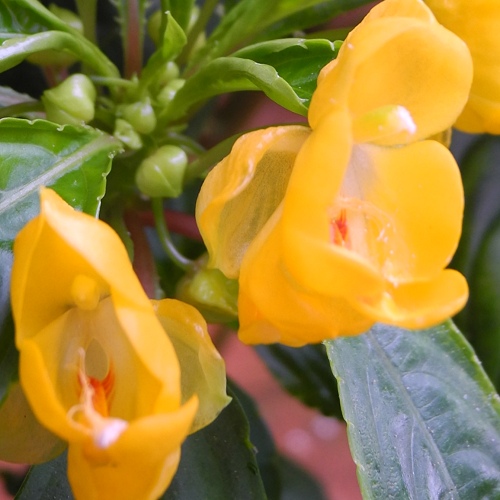| Home |
Strange Wonderful Things
Rare and exotic plants
|
 |
Impatiens auricoma

Germinating the seeds
When to plant -- Plant your seeds when you receive them for best germination.
Getting started -- You may plant each seed in individual, small containers. Or you
can plant them all in a single
container, but it may be more difficult to transplant them later. Either way, use pots with drainage holes
For soil, use a well draining mix high in organic matter. A typical mix is 2 parts potting soil to 1 part
perlite (use small- or medium-size perlite, not large chunks) or
coarse sand. An alternate mix is 1 part
coco fiber
(use small- or medium-size perlite, not large chunks) or
coarse sand. An alternate mix is 1 part
coco fiber to 1 part
perlite, with some slow-release fertilizer
mixed in.
to 1 part
perlite, with some slow-release fertilizer
mixed in.
Fill the pots with soil and place a seed or 2 on the surface. If you
have
long-fibered sphagnum moss (not ground peat moss), sprinkle some on the
surface. This helps retain moisture around the seeds while allowing light
to reach them, which aids germination.
This photo shows how much moss to use.
If you don't have the moss, sprinkle some of your soil mix around the seeds. Add water until everything is evenly moist (but not soggy).
Until the seeds sprout, ensure that the surface soil always stays moist. A plastic dome or bag
is good for maintaining moisture, but leave it open a crack to allow some fresh air in. You may need to drip a few drops of water over the seeds every day to keep the seeds
moist.
The ideal temperature for germination is between 65 to 77 degrees F (18-26°C). A little cooler at night is ok.
Avoid letting them get above 80° F (27°C) for prolonged periods. I recommend placing a
minimum/maximum thermometer near the pots.
Keep them in bright light out of
direct sun. A bright LED or fluorescent bulb kept 4 inches (10 cm) away provides
the right amount of light (See: "Growing indoors with LED lights").
They tend to start germinating in about 3 to 5 weeks, but may take up to 8 weeks
to start.
Increase air ventilation slightly after sprouting to prevent rot, but continue keeping the
soil surface moist for 2-3 weeks after sprouting.
Growing onward...
Lighting -- This Impatiens prefers bright shade, or filtered sunlight. Avoid prolonged direct sun, unless it's early-morning sun.
Fertilizing -- The first 6 weeks, feed weekly with a small amount of dilute
(1/8 strength) liquid fertilizer.
Hydroponic fertilizer
is ideal for young seedlings, since it is easily absorbed and contains all
essential nutrients.
After 6 weeks, you may switch to a granular fertilizer that contains
micronutrients, feeding at half the dosage on the package. Or continue
feeding weekly with some dilute liquid fertilizer.
Transplanting -- When your plants are 2-3 months old, you may gently
transfer them to a larger pot. Water the soil first, and avoid letting the
soil ball break apart, which can damage the roots. After transplanting,
give no sun or liquid fertilizer the first week.
Watering -- Aim to keep the soil moist, but not soggy. Never let it dry
out completely. You may use a moisture meter probe to monitor the moisture levels down in the root zone.
Climate -- I don't know the climate
tolerances of this species, but some related African Impatiens
prefer temperatures below 85 degrees F (29 C), and lag when it gets warmer than this,
especially if nights are warm. It has handled temperatures in the mid-30s,
but i don't know if it can survive frost. You may save the seeds each year
and grow the plant as an annual.
Above about 45-50% humidity is
best. If your plants suffer in low humidity indoors, consider using an ultrasonic room humidifier,
sold at
home improvement stores and some thrift shops.
It's normal for a leaf to occasionally turn yellow and drop, but if it seems excessive, the soil may be too dry down in the root zone,
or the plant may need more fertilizer.
Pests to watch for -- aphids, scale (dark disks on the stems), mealy
bugs. Try using
insecticidal soap
spray
before using stronger remedies, since some may harm the plant.
Have fun growing them!
- Jeff
Strange Wonderful Things
| Home |
Strange Wonderful Things
Rare and exotic plants |

|
| Entire site Copyright 2003-2025 by Strange Wonderful Things, except as noted |
|


